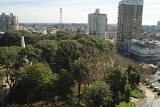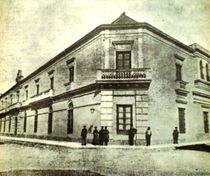
Concepción del Uruguay
Encyclopedia
Concepción del Uruguay is a city in Argentina
.
It is located in the Entre Ríos
province, on the western shore of the Uruguay River
, some 320 kilometers north from Buenos Aires
. Its population is about 65,000 inhabitants .
. Rich in ancient monuments, it is sometimes referred to as La Histórica ("The Historical") due to is participation in the national formation process. The Palacio San José
, the old personal residence of caudillo
Justo José de Urquiza
is located only 23 km from Concepción.
There are discussions about the full name of the city, as some versions say it was merely Concepción del Uruguay.
In 1814 the Supreme Director Gervasio Antonio Posadas, using the extraordinary powers given by the Constituent Assembly, named Concepción del Uruguay as the capital of the province of Entre Ríos at the time of its creation. On June 29, 1815, General José Gervasio Artigas convened the first congress independence, which was held in the city with the name of Congress East. It was meant for the declaration of independence Argentina and the adoption of the flag created by Belgrano straddles the currency punzó-red diagonal stripe symbolizing federalism.
It was also decided not to attend Congress of Tucumán to be held the following year as a sign of protest toward Directory (unit) to promote the Portuguese invasion in Banda Oriental and attacks on federal deputies.
On February 1, 1820, General Francisco Ramírez, allied with the governor of Santa Fe Estanislao López, who commanded the federal army defeated José Rondeau at the battle of Cepeda, shortly after signing the Treaty of Pilar. Subsequently, Ramírez was distanced from López and September 29 of that year, proclaimed the Republic of Entre Ríos, which included addition to the existing provinces of Corrientes and Misiones, Concepción being the capital of Uruguay. But the life of this republic would be short-lived, since they would disband with the death of Ramírez on July 10, 1821.
In 1826, General Justo José de Urquiza, in his role as the governor of Entre Rios, promoted the law that gave Concepción del Uruguay range city.
In 1848 Urquiza created in the City College of Uruguay, first in the country of secular character.
In 1851, at the foot of the pyramid's central Plaza, General Francisco Ramirez, the pronouncement of Urquiza took place against Juan Manuel de Rosas, an act that would lead to the battle of Caseros on February 3, 1852, in which Urquiza was the winner and which paved the way for enactment of the National Constitution the following year. Also in 1852, troops from Buenos Aires led by General Madariaga disembark frustrated with the aim of taking the city.
The Provincial Convention gathered in the city in 1860 to punish the provincial Constitution again declare the provincial capital, which would function until the year of the centennial, 1883, when the capital was finally moved to the city of Paraná.
On January 1, 1873 the town was formally created. Also the same year, during the boom of normalcy, Sarmiento created in the city the second Normal School in the country, after the first of Paraná and women.
In 1994 was held at the Palacio San José the swearing of the Constitutional Reform.
nationals, people from Concepción del Uruguay are called uruguayenses, while Uruguayans are known as uruguayos.
and Colón
make up 85% of Argentine chicken exports. http://www.lacapital.com.ar/2006/06/12/economia/noticia_301246.shtml

Argentina
Argentina , officially the Argentine Republic , is the second largest country in South America by land area, after Brazil. It is constituted as a federation of 23 provinces and an autonomous city, Buenos Aires...
.
It is located in the Entre Ríos
Entre Ríos Province
Entre Ríos is a northeastern province of Argentina, located in the Mesopotamia region. It borders the provinces of Buenos Aires , Corrientes and Santa Fe , and Uruguay in the east....
province, on the western shore of the Uruguay River
Uruguay River
The Uruguay River is a river in South America. It flows from north to south and makes boundary with Brazil, Argentina, and Uruguay, separating some of the Argentine provinces of the Mesopotamia from the other two countries...
, some 320 kilometers north from Buenos Aires
Buenos Aires
Buenos Aires is the capital and largest city of Argentina, and the second-largest metropolitan area in South America, after São Paulo. It is located on the western shore of the estuary of the Río de la Plata, on the southeastern coast of the South American continent...
. Its population is about 65,000 inhabitants .
History
The city was founded on June 25, 1783 by Tomás de RocamoraTomás de Rocamora
Juan Tomás Julián Marcos de Rocamora y del Castillo was the governor of three provinces and the founder of several towns in Entre Ríos Province, Argentina....
. Rich in ancient monuments, it is sometimes referred to as La Histórica ("The Historical") due to is participation in the national formation process. The Palacio San José
Palacio San José
The San José Palace is the former personal residence of Justo José de Urquiza, Argentine caudillo, general, politician and President of the Argentine Confederation from 1854 to 1860...
, the old personal residence of caudillo
Caudillo
Caudillo is a Spanish word for "leader" and usually describes a political-military leader at the head of an authoritarian power. The term translates into English as leader or chief, or more pejoratively as warlord, dictator or strongman. Caudillo was the term used to refer to the charismatic...
Justo José de Urquiza
Justo José de Urquiza
Justo José de Urquiza y García was an Argentine general and politician. He was president of the Argentine Confederation from 1854 to 1860.He was governor of Entre Ríos during the government of Juan Manuel de Rosas, governor of Buenos Aires with powers delegated from the other provinces...
is located only 23 km from Concepción.
Background
A populated area known as Arroyo de China (which had no foundation), was recorded in approximately 1778 and located north of the namesake creek in what are now the neighborhoods of Puerto Viejo and La Concepción in the extreme south of the city. The same year the first chapel was erected at a place that would subsequently be used as a cemetery.Foundation
Commissioned by the viceroy of Vértiz and Juan Jose Salcedo, Thomas Rocamora founded the town of Our Lady of the Immaculate Conception of Uruguay on 25 June 1783, lifting the first town north of the existing population to what is now the administrative and commercial centre of the city.There are discussions about the full name of the city, as some versions say it was merely Concepción del Uruguay.
Epicentre of the national scene
In 1810, aware of the movement that had been raised in Buenos Aires, the city was the first to join the cause of the Revolution.In 1814 the Supreme Director Gervasio Antonio Posadas, using the extraordinary powers given by the Constituent Assembly, named Concepción del Uruguay as the capital of the province of Entre Ríos at the time of its creation. On June 29, 1815, General José Gervasio Artigas convened the first congress independence, which was held in the city with the name of Congress East. It was meant for the declaration of independence Argentina and the adoption of the flag created by Belgrano straddles the currency punzó-red diagonal stripe symbolizing federalism.
It was also decided not to attend Congress of Tucumán to be held the following year as a sign of protest toward Directory (unit) to promote the Portuguese invasion in Banda Oriental and attacks on federal deputies.
On February 1, 1820, General Francisco Ramírez, allied with the governor of Santa Fe Estanislao López, who commanded the federal army defeated José Rondeau at the battle of Cepeda, shortly after signing the Treaty of Pilar. Subsequently, Ramírez was distanced from López and September 29 of that year, proclaimed the Republic of Entre Ríos, which included addition to the existing provinces of Corrientes and Misiones, Concepción being the capital of Uruguay. But the life of this republic would be short-lived, since they would disband with the death of Ramírez on July 10, 1821.
In 1826, General Justo José de Urquiza, in his role as the governor of Entre Rios, promoted the law that gave Concepción del Uruguay range city.
In 1848 Urquiza created in the City College of Uruguay, first in the country of secular character.
In 1851, at the foot of the pyramid's central Plaza, General Francisco Ramirez, the pronouncement of Urquiza took place against Juan Manuel de Rosas, an act that would lead to the battle of Caseros on February 3, 1852, in which Urquiza was the winner and which paved the way for enactment of the National Constitution the following year. Also in 1852, troops from Buenos Aires led by General Madariaga disembark frustrated with the aim of taking the city.
The Provincial Convention gathered in the city in 1860 to punish the provincial Constitution again declare the provincial capital, which would function until the year of the centennial, 1883, when the capital was finally moved to the city of Paraná.
On January 1, 1873 the town was formally created. Also the same year, during the boom of normalcy, Sarmiento created in the city the second Normal School in the country, after the first of Paraná and women.
Late 19th and early 20th century
June 30, 1887 was enabled the rail link across the line which is then integrated into the General Urquiza Rail with the cities of Paraná, and Rosario Nogoyá of Tala. Also that year was reformed port, which in 1910 reached their best time from his office be one of the most important country.Industrial development
Throughout the twentieth century, the city continued to hold importance to cultural and economic level, adding to the processes of industrialization underway in the country and settling their major industries.In 1994 was held at the Palacio San José the swearing of the Constitutional Reform.
Uruguayenses
To distinguish its citizens from UruguayanUruguay
Uruguay ,officially the Oriental Republic of Uruguay,sometimes the Eastern Republic of Uruguay; ) is a country in the southeastern part of South America. It is home to some 3.5 million people, of whom 1.8 million live in the capital Montevideo and its metropolitan area...
nationals, people from Concepción del Uruguay are called uruguayenses, while Uruguayans are known as uruguayos.
Economic life
Today the city has three major industries: the port, the industrial park (poultry, woods, auto-parts) and the state administration (including five faculties). The Uruguay Department produces 47% of the nation's poultry, and Concepción del Uruguay together with GualeguayGualeguay
Gualeguay may refer to:* Gualeguay, Entre Ríos* Gualeguay Department* Gualeguay River...
and Colón
Colón, Entre Ríos
Colón is a city in the . It is located in the east of the province, on the western shore of the Uruguay River, and has about 21,000 inhabitants...
make up 85% of Argentine chicken exports. http://www.lacapital.com.ar/2006/06/12/economia/noticia_301246.shtml

Education
The city has four universities, of which three are public (two national and one provincial) and the other one is private. They totalled ten faculties, thereby providing a broad academic offerings in different areas. In turn, two of the aforementioned institutions have headquarters in the city of his rectory, confirming its importance as the largest educational center in the region.External links
- Information and history
- Concepción National University (Spanish)
- On its foundation (Spanish)
- Tourism in Concepción (Spanish)

